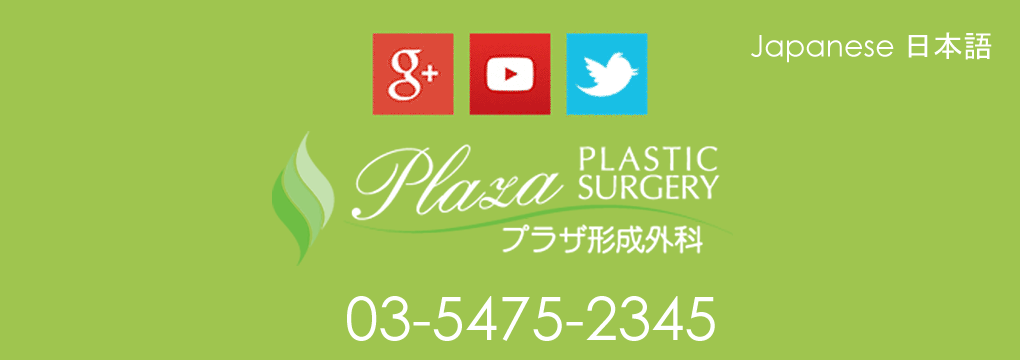NON-SURGICAL PROCEDURES DERMAL FILLERS – Botox
Hyaluronic Acid (Restylane, Juvederm)
Mesotherapy (Fat dissolving injection therapy)
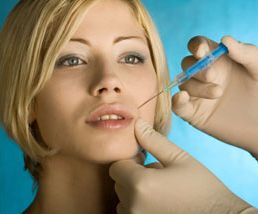
U.S. board-certified plastic surgeon provides various treatment options
Botox Injections in Tokyo Japan
As you may know, Botox is a neurotoxin that paralyzes muscles. We utilize this mechanism to immobilize unnecessary motions of muscles in frown lines, forehead wrinkles, and so forth. It is done in a very controlled fashion, therefore the risks are minimal.
Although Botox injection is done with the smallest needle available in the market and not significantly uncomfortable, we provide local anesthesia, anesthesia cream, and ice application for those who are extremely sensitive.
It is done within a few minutes usually by our U.S. board-certified plastic surgeon, and no follow-up is necessary. The average cost for Botox Japan treating frown lines is from 30,000 yen + tax.
Our doctor, Dr. Robert Kure has been treating people with facial lines with Botox for more than 15 years since his previous practice in Los Angeles and Beverly Hills. The procedure takes only a few minutes and the effects of Botox last for 4-5 months or longer for the facial wrinkles. If you have permanent lines (creases) such as in the frown lines, an additional treatment with hyaluronic acid (Restylane, Juvederm) may be effective to alleviate the deep lines.
Special Offer
> 15% off for Botox when more than 2 areas* are treated.
(*Definition of “one area” – Forehead, Crow’s feet (both sides), or Frown line area and these discounts apply only to the above-mentioned regions.)
For example, if you get botox treatment for forehead and frown lines – the regular price is 60,000 yen plus tax but because of the discount, the final price will be 50,000 yen plus tax (17% off of the regular price). If you get all 3 areas treated, instead of 90,000 yen plus tax, your price will be 70,000 yen pus tax (more than 22% off of the regular price).
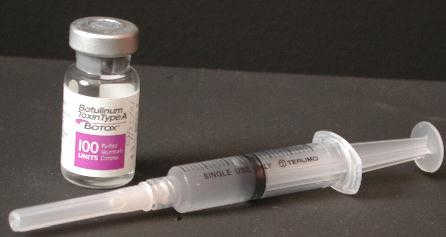
Example of Botox Treatment
Botox can be used to correct unwanted wrinkles of frown lines (below) to lower the upper lip to cover the gummy smile (right), crow’s feet, forehead wrinkles, and many more indications. [Pictures from Allergen, Inc. brochure.]
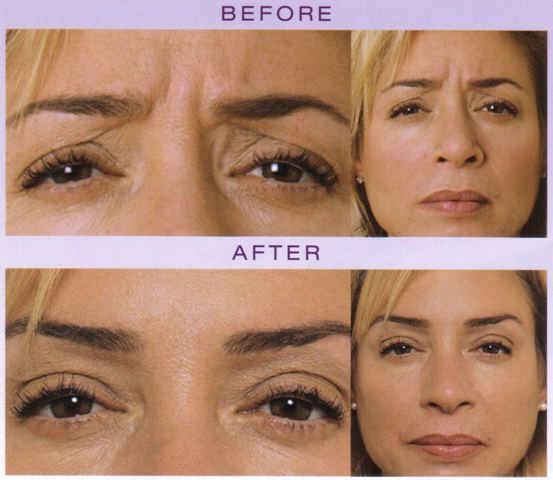
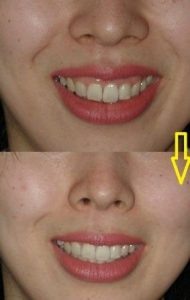
The doctor will explain detailed applications of Botox currently known. (click each line for more details, and click again to close the window)
What is Botox
Botulinum toxin is a toxin created by bacteria called Clostridium botulinum. These bacteria grow in environ- ments where no air exists, and they discharge exotoxin out- ward. They are distributed widely in soil, seas and wet- lands all over the world. Many readers may remember Clostridium botulinum from familiar reports of food poi- soning caused by canned food, which is heard from time to time. Since they propagate in anaerobic environments, they breed not only inside cans but also in inadequately steril- ized bottled and vacuum-packed foods, and they generate strong toxin. Recent primary concerns are homemade pre- served food (marine products) and souvenirs from overseas, including vacuum-packed marine products. Cases of food poisoning due to smoked, pickled or salted fish, caviar, soft cheese and similar products have been reported. The symp- toms of food poisoning–including nausea, vomiting, a sense of exhaustion, fatigue, dizziness–start to appear 8 to 36 hours after the food is consumed, and such symptoms are followed by double vision and the loss of ability to speak. In severe cases food poisoning can be life-threatening.
Given the explanation above, you may wonder why such a dangerous substance is used for medical treatment. In med- ical practice the physician uses a tiny amount of botulinum toxin under controlled conditions, in which case it is very safe. You can rest at ease, because only botulinum toxin products approved by the FDA can be used for medical pur- poses in the U.S. The use of other products is not approved.
The toxin of this bacterium is classified into seven different types: A, B, C-alpha, C-beta, D, E, F and G. This is because each type of toxin aims for a different target, although they all act on the nerve cells. Type-A botulinum toxin (e.g. with the product name Botox, made by Allergan in the U.S.) has the effect of disabling the ends of neurons, so that they cannot send signals. First, when type-A botu- linum toxin is injected into the treated site with a small nee- dle, it enters the nerves and acts on the protein in the cells, preventing a neurotransmitter called acetylcholine from
leaking to the outside. There are types ranging from A to G, because each type blocks a different type of protein. Without acetylcholine, signals are not transmitted from one nerve to another, and as a result the muscles become unable to contract. It takes 24 to 48 hours for such effects to appear. The effects reach their peak in two to three weeks but then diminish and disappear in about four months (six months at the longest). The reason why the effects are lost in four months is that, although the ends of neurons that became useless are annihilated immediately, new projec- tions called “sprouts” come out one after another from dif- ferent parts toward the muscles, in a process that takes four to six months. Note that in the U.S. not only is the type-A toxin Botox available but also the type-B toxin called Myoblock, which is sold by a different company. Outside the U.S., a product called Dysport® has been sold in the United Kingdom first, and now FDA approved. There seem to be botulinum toxin products made in other countries as well, but they are excluded from this discussion because the FDA has not examined those products.
Forehead lines
Wrinkles on the forehead are formed due to the contraction of the frontal muscles, which are controlled by facial nerves. These muscles are connected from the lower side of the forehead to the top of the head (Figure)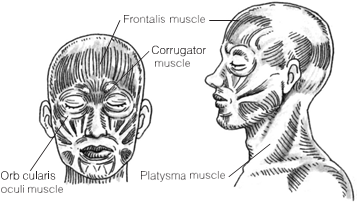 and form wrinkles that run horizontally across the forehead when we make a surprised expression. If such a gesture is repeated often, it will eventually form deep wrinkles on the forehead even if you do not tend toward such an expression.
and form wrinkles that run horizontally across the forehead when we make a surprised expression. If such a gesture is repeated often, it will eventually form deep wrinkles on the forehead even if you do not tend toward such an expression.
Actual treatment methods vary, but a representative method employed in the U.S. is to inject Botox into the inner sides of both the left and right pupils only (Figure) . With this method, horizontal wrinkles on the entire forehead are removed almost completely and one-third of the outer sides of the eyebrows are lifted at an angle of approximately 15 degrees. This method is preferred because eyebrows with their outer sides lifted by a small angle are regarded as beautiful in the American standard (and probably the Japanese standard as well). The standard of beauty varies depending on national characteristics, however. In a neigh-boring Asian country, for example, parallel eyebrows are preferred, in which case different treatment methods are employed (but injection into the outsides of the pupils is also required).
. With this method, horizontal wrinkles on the entire forehead are removed almost completely and one-third of the outer sides of the eyebrows are lifted at an angle of approximately 15 degrees. This method is preferred because eyebrows with their outer sides lifted by a small angle are regarded as beautiful in the American standard (and probably the Japanese standard as well). The standard of beauty varies depending on national characteristics, however. In a neigh-boring Asian country, for example, parallel eyebrows are preferred, in which case different treatment methods are employed (but injection into the outsides of the pupils is also required).
If Botox is to be injected in a wide area of the entire forehead, it becomes important to obtain a well-written informed consent before the treatment is performed. This is due to the possibility of side effects: The entire forehead may become heavy and drop down. In the worst case sce- nario the eyelids might sag downward, making it difficult to open the eyes. It is reported that such side effects are seen only in several percentage points of patients who have had Botox injections across a broad area of the forehead. The effects, however, will diminish in two to three weeks, if they occur at all, or will turn for the better through the use of special eye drops. Nevertheless, precautions must be taken. Note that such side effects are seen only rarely in the aforementioned cases where only the insides of both pupils are treated. One injection provides effects that last for four to five months.
Are there wrinkle treatment techniques other than Botox? Yes, there are. Before the use of Botox, even an overdone method called browlift was used, where the scalp on the upper forehead (above the hairline) is cut to peel the fore- head skin and cut the muscles beneath it into pieces. Such methods are seldom used anymore. Moreover, in my opin- ion, creams, peeling, laser, are unable to treat wrinkles occurring on the forehead.
Other applications of Botox: (click each line for more details)
Migraine Headaches
We now know the fact that a considerable number of patients who have been receiving Botox treatments for cosmetic purposes have claimed to be cured of obstinate migraine headaches and other types of headaches, almost coincidentally. Initially no one knew why such a phenomenon occurred, because a migraine headache was believed to be caused by problems in the membrane covering the surface of the brain (membranous coverings) and the blood vessels in the brain. Several hypotheses have been proposed in recent years, and now there are movements to review the concepts and mechanisms of migraine headache, through Botox treatment.
Dr. Kure has worked as a medical specialist in plastic surgery and aesthetic surgery in the U.S., and has been impressed by the wonderful effects of Botox on various occasions. He has treated many patients who used to receive the treatment for cosmetic purposes and eventually changed their purpose in seeing me to one involving the treatment for their headaches.
He is a physician who originally specialized in neuropathology and neurosurgery. In the past he has also examined many patients suffering from headaches. *Dr. Kure was formerly trained in neuroscience prior to the plastic surgery training, and he is board-certified in neuropathology (USA) and board-eligible in neurosurgery (USA). Because of such background, Dr. Kure also sees patients suffering from migraine headaches. He has been treating these patients with Botox.
* To check Dr. Kure’s credentials regarding the neuroscience background, please check the following independent sites:
American Board of Medical Specialties (ABMS)
Neurosurgery residency alumni listing (year of 1998)*
The FDA approved Botox as a treatment for headaches in October 2010.
Botox treatment for the headaches start from 20,000 yen + tax.
Bell’s palsy
Botox has been used to treat conditions associated Bell’s palsy. Bell’s palsy is a hemifacial paralysis resulted from viral infection or unknown causes. It results in asymmetric face including difficulty in closing the affected eyelid, droopy lip, nasolabial line (smile line) and so forth. Botox can alleviate these symptoms associated with Bell’s palsy. One of our staff (Dr. Robert Kure) has been trained not only in plastic surgery but also in neurosurgery in the United State, and is qualified to treat patients with Bell’s palsy.
Nasal (pollen) allergy
It is not an injection but just drops of medicine applied on the nasal mucosa. Please ask our doctor for more details.
Cost: 12,000 yen plus tax for the initial treatment and 8,000 yen plus tax for an additional one within a month.

Bruxism
The habit of grinding teeth is known as “bruxism.” According to a survey by Baylor University in the U.S., it is seen in more than 8% of the population, which means that there are huge numbers of patients. Looking at Japanese data, some report that more than 30 million people suffer from bruxism. Then, why does bruxism occur? What types of people does it occur with, and what are the consequences? A closely related symptom called “temporomandibular disorder,” which I will discuss later, is often observed among young women, but bruxism lacks rational symptoms in general and is seen in people with all kinds of occupations regardless of gender. It is said that many instances of bruxism occur during sleep due to occupational and/or social stresses, and that such people relieve the stress by grinding their teeth. There are also reports claiming that bruxism is often seen among heavy smokers and heavy coffee drinkers. There are cases of habitual bruxism, for example baseball players clenching teeth when swinging a bat, as well as those caused by abnormal teeth alignment.
The rational symptoms felt by some people include a dull feeling in the jaw or tensed jaw muscles (area under the ears) when getting up in the morning. However, in most cases bruxism is difficult to diagnose. If there is another person whose sleeps in the same room, such as a spouse, that person may point out objective symptoms such as rasping and crunching noise (called grinding) or a ticking noise (called tapping). If the conditions advance, not only can dental problems such as breaking and cracking of teeth occur but also the jaw joints may be affected, causing temporomandibular disorders (pain in the jaw, the mouth not opening easily, etc.). In some cases the problems are not limited to the jaw but also appear as pain in the neck or in the back of the head (a type of tension headache) or can be neurologically related to the apnea syndrome. As such, they should never be taken lightly. On the other hand, in the U.S. there are reports that many people who snore also gnash their teeth during sleep.
Conventional treatment techniques include wearing devices that prevent bruxism (e.g. a mouthpiece) and dental techniques such as orthodontics. They seem to be effective for significant percentages of patients, but there are still many patients who suffer from prolonged persistent symptoms. A method that uses Botox to treat patients for whom existing treatment techniques are not effective has been tried out lately in the U.S. and elsewhere. A neurology medicine group at Baylor University School of Medicine, as mentioned earlier, reported in a paper published in 2000 that they had treated 18 patients of persistent bruxism by injecting 25 to 100 units of Botox into the affected jaw muscles and, as a result, observed significant effects in all the patients. Extremely obstinate bruxism is also observed in patients with disorders of the brain, and the effects of Botox have been recognized in such cases. Similar reports are not published in the U.S. alone but also in Europe.
Given the treatment policy for bruxism, if such symptoms are suspected the author recommends that a dental surgeon perform the therapeutic treatment. If expected effects are not obtained or treatment with mouthpiece is intolerable, it may be a good idea to try Botox treatment performed by an experienced clinician.
TMJ pain (temporomandibular disorder)
Temporomandibular disorder is abbreviated as TMD. The cause of this disease is not limited to a single cause. It involves pain from the jaw to the face caused by problems in the muscles that constitute the jaw joints and/or surrounding muscles, and it is considerably difficult to cure because the causes vary.
It might also be caused by advanced bruxism as described above. TMD, which differs from bruxism, is often seen among women in their twenties and thirties, which is one of its key characteristics. For these reasons certain specialists point out problems in congenital jaw development and the jaw joints.
Since this disease is outside the specialties of us physicians (dental surgeons specialize in the disease), it is described only briefly in this site. Conventional medical treatments include the insertion of devices such as a mouthpiece and splint into the mouth or the use of a drug to reduce the tension of the muscles.
Botox seems to have the effect of relieving the symptoms, particularly when the problems are clearly caused by excessive tension of the muscles, among the various symptoms of TMD. A sufficient history of case studies has not yet been announced according to my research of American literature, so we cannot say anything decisive yet. However, we believe it is important for the patient who suspects such a condition to consult with a dental surgeon specializing in the temporomandibular disorder before any treatment is received.
Hyperhidrosis of underarm (over-sweating)
It was about the year 2000 that Botox started to be employed to treat hyperhidrosis of the underarm, but only in the past year or two has Botox treatment become known among the general public through trial and error in treatments (in the U.S.). There are two types of sweat glands in the underarm: one type is the apocrine gland, which is mainly related to odor; and the other is the eccrine gland, which is related to sweat. The former exists in large quantities around the hair roots, and the latter exists in slightly deeper layers and is involved in regulating body temperature (via sweating). For this reason the eccrine gland is closely associated with the autonomic nerves. The sympathetic nerves, in particular, control the secretion of sweat.
The symptoms of hyperhidrosis are observed with one in 100 people and involve conditions where a large and uncontrollable amount of sweat is secreted from the underarms and palms. Generally, it is said that the amount of sweat secreted is as much as ten times greater than normal people, which adversely affects one’s social life due to the staining of clothing, etc. In the past, various treatments were attempted, for example commercially available products containing aluminum chloride, which is believed to work for hyperhidrosis. However, the effects have been variable. Psychological treatments are also attempted in cases where the symptoms are caused by psychological factors. Also, if the symptoms are related to other diseases, for example obesity, menopausal syndrome, side effects of drugs (e.g. anti-psychotic agents), hormonal disorders (e.g. hypoglycemia, hypothyroidism) and neurological diseases (e.g. autonomic nerve disorder), it is of course necessary to treat the causes.
Surgical treatment techniques include the removal of sweat glands, but perfect effects cannot be obtained. Additionally, there is a technique called sympathectomy, which destroys the sympathetic nerve nodes. However, there is considerable difficulty in this procedure because it destroys the nerves adjacent to the spinal cord using a chest mirror, and severe side effects such as paralysis in other nerves, pupillary abnormalities called Horner syndrome and abnormal sweating in various parts of the body can occur.
In this sense, Botox could be called a breakthrough method that can control hyperhidrosis of the underarm in a period of four to six months, doing so with a high degree of safety. Several mechanisms are considered with respect to how Botox works for hyperhidrosis. It has been suggested that the nerve transmitter substance called acetylcholine is directly related, or that Botox influences other nerve transmitter substances at the endings of the autonomic nerves. In any case, it is interesting that the nerve toxin called Botox would be involved even with the regulation of sweat. Although there is little in the way of side effects, it is important to inject Botox exactly at the sweat glands, which are located between a deeper part of the skin (called the dermis) and the subdermal fat. Otherwise the expected effects will not be obtained. If injected too close to the surface of the skin, there is a possibility that Botox may not reach the endings of the neurons that control the sweat glands. Botox can control not only the hyperhidrosis of the underarm but also that of hands (palm), and feet.
Slenderizing the jaw muscle

Slenderizing the legs
Botox is used by some physicians as a treatment to slenderize the muscles in the calves. We no longer use this technique, however. Theoretically we can easily imagine that Botox would be effective, but the problem is the significantly large area occupied by the muscles in the calves. This means a large amount of Botox must be injected in order to obtain sufficient results.
In our opinion it is better not to use U.S.-made Botox in an amount exceeding 100 units per patient (the strength varies by the producer, even though it is the same botulinum toxin) in order to get good results, because the excessive use of Botox may cause problems over the entire body in some patients, such as a slight attack of fever as if one were sick with a cold, or generalized fatigue.
Special precautions should also be used when administering a large amount of Botox to a young female patient. Since Botox must not be used during pregnancy, the physician must ask the female patient about her condition, bearing in mind the possibility of beginning pregnancy, which is difficult to know, before considering such treatment.
Stiff neck and shoulders
Botox is also used to treat dystonia of the neck, the myofascial syndrome (a painful disease of the muscles and fascia), and whiplash syndrome. When explaining it this way, one might think I sound like an acupuncture specialist who claims that his needles are effective for every malady or condition.
However, we think that the acupuncturist’s needles and Botox work the same way in terms of their ultimate effects. In the case of needles, signals are sent from the peripheral nerves in order to control the gates of pain, but there is the shortcoming that the sustained duration is shorter than that provided by Botox. Moreover, Botox treatment uses extra-fine needles, which I believe are less painful than acupuncture treatment in general.
In any case Botox has been used for pain and stiffness of the neck and shoulders for many years now, and its effectiveness is proven. It is necessary to have the problem diagnosed properly by a medial specialist (neurology or neurosurgery) first before receiving treatment by a medical specialist experienced in Botox treatment. If the first diagnosis is wrong, not only will the expected treatment effects not be obtained, but the treatment will be risky as well.
Tennis elbow
This is a very common condition, but actually it is not related to the elbows themselves. The cause is the squeezing of the nerves by an abducent muscle called the supinator, which tightens up when the forearm is extended (extensor muscle) or rotated outward, or by inflammation of the tendons around the elbow.
In clinical reports in the U.S. and Europe, it is indicated that the symptoms have been alleviated in more than 50% of patients by injecting Botox into the muscles.
Piriformis syndrome
There is a location in the lower back, slightly above the bone that comes in touch with a chair when sitting down, where the sciatic nerves protrude from the pelvis. The piriformis muscle is the muscle that runs diagonally across the location from the center of the pelvis to the femur. If this muscle is swollen or excessively tense, it irritates the immediately adjacent sciatic nerves, causing tremendous pain. Patients who suspect low back problems may actually suffer from piriformis syndrome. Since accurate diagnosis may be difficult for an ordinary physician to make, it is first necessary to consult a medical specialist in neurosurgery, orthopedics (bones and muscles) or neurology.
Data obtained in the U.S. indicates that considerable effects can be obtained using Botox treatment in cases of piriformis syndrome.
Thoracic outlet syndrome
This syndrome is caused when the nerves and blood vessels are oppressed in the area extending from the chest to the neck, and it can occur for many reasons. Symptoms include numbness in the arms or the inability to lift the arms upward. A condition often seen as problematic is the one in which the scalenus muscle, which runs from the tibia to the os costale, oppresses the nerves that lead to the arm nearby. Diagnosis is very important and must be made by a medical specialist in neurosurgery or neurology.
Treatment using Botox is reported to be effective for thoracic outlet syndrome. Treatment must also be performed by a medical specialist, since it is necessary to inject precisely at the target muscle.
Phantom pain
Phantom pain refers to a condition where a patient whose leg has been amputated, for example, feels an acute pain running from the edge of the amputation to the (non-existing) toe. In this sense “phantom” means a ghost or illusion.
According to clinical data in the U.S., there are reports that pain and frequency of pain attacks in 60% to 80% of patients could be relieved by injecting Botox into the muscle located at the edge of amputation.
Gastrointestinal pain
I will explain this briefly before it is asked why we, plastic surgeons, would write about pain in the gastrointestinal system. In the U.S. and Europe, Botox is used to treat pain after operations of, for example, anal fissure and hemorrhoids, as well as Achalasia, a condition where the muscles of the digestive canal contract too much. Good results have been obtained in these cases.
Hyperhidrosis (over-sweating) of armpits, hands and feet are now effectively treated with Botox injection. Please consult our specialist for more details.
| 「New You with Botox」 (English) (ISBN978-4-434-11079-5) |
Botox for Migraine Headaches–please click here for more information regarding Botox and headaches
[top]
Hyaluronic Acid (Restylane, Juvederm) – Tokyo Japan
Hyaluronic acid (HA) injection is effective to correct facial line (personally done by the U.S. board-certified plastic surgeon). Smile lines (nasolabial lines), the oblique line under the eyes, Marionette lines, lip augmentation, and more can be treated. It works since it is a high molecular sugar that can attract nearby water to the molecule, therefore the tissue will swell up and expand. Treatment cost from 50,000 yen + tax.
Liquid face lift:
The concept of “Liquid face lift” was developed in the United States recently. The injected hyaluronic acid formulation aimed at the tear-trough and/or in the upper cheeks will give volume effects in these areas and resulting in younger looking, augmentation of upper cheeks. This technique is especially good for somebody with flat midface. It is a rejuvenating non-surgical treatment. You will find more in details by searching under “Liquid Facelift” for more information.
In our hospital, we use liquid face lift with hyaluronic acid called Judederm made in France.
Treatment cost for liquid facelift: 80,000 yen (excluding tax)
HA can be also used for chin augmentation and refining the shape of nose (e.g. higher nasal bridge).
It can last up to 6 – 9 months. It starts from 10,000 yen/0.1cc (minimum starting dose – 50,000 yen + tax). The pre-treatment to reduce the pain is similar to those of Botox. It can be done without almost no pain if you wish so (additional fee may apply).
We use only genuine American or European products imported.
Special Offer on Dermal Fillers
> 10% off for Hyaluronic acid injection (Restylane, Juvederm) if more than 2 syringes used.
Please mention this special offer when you make an appointment! Some of the best prices for Botox Injections in Tokyo Japan.
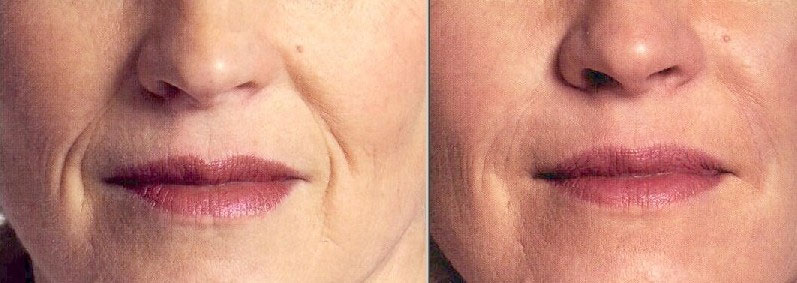
Photos from brochure of Restylane.

Upper lip augmentation
Painless treatment for Botox and Restylane can be done by using “block anesthesia methods”. Intra oral block anesthesia is first given to the sensory nerves of the face (this injection itself is not painful), then either Botox or Restylane injection is done without so much pain at all. This approach is usually done the U.S. for the patients sensitive to pain.
Mesotherapy (Fat Dissolving Injection)
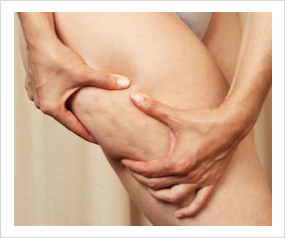
Mesotherapy is a non-surgical treatment to reduce unwanted fat in various areas of the body. It utilizes fat-dissolving chemical solution that was originally described in Europe many years ago. Treatment itself is non-surgical with mild ~ moderate irritation upon injection.
It is also effective way to treat cellulite of the buttocks and thighs. By reducing the superficial fat layers of these lesions, the cellulite will gradually become less obvious.
Minor bruises are seen sometimes but self-limiting. Fee starts from 25,000 yen plus tax for a palm size.
There are two types of typical mesotherapy (lipolytic injection) agents, one is Phosphatidyylcholine (PC for short), which has been known for a long time, and the other is deoxycholic acid, whose efficacy has been attracting attention in recent years. The latter comes with a salt form (Sodium Deoxycholate: DC for short) and also known for the ingredient for the famous Kybella.
At our clinic, we prepare both of the above medicines and recommend the optimal treatment method while analyzing the state of fat accumulation in each patient.
*Depending on the amount of the fat deposition, other treatment such as liposuction may be more optimal than the mesotherapy. Learn more about mesotherapy.
*If you decide to have the traditional liposuction after having series of mesotherapy, you’ll get 20% off toward the liposuction.
Other treatment
Other fillers:
In injections to subcutaneous tissues other than hyaluronic acid, historically well-known ones include collagen, artificial objects such as PMMA with artificial bone cement (Artecol etc.), including calcium phosphate (Radiesse) there is. The details are summarized below.
Dermalive (substance size is 40-60 micron), Dermadeep (100- 120 micron) – Acryl Hydrogel 40% nonabsorbable polymer and hyaluronic acid 60%. The latter is absorbed by bacteria, crosslink +, 6-8 weeks. It is used for lips, cheeks, nostrils, and so on. Evolence is collagen from Israel. It is said that the number of cross links is large and lasts 12 to 18 months. Aquamid is a liquid plastic and we don’t think safe to use because of high chance of permanent granuloma formation.
Some of these formulations are more frequent to develop more severe lumps or granulomas difficult to remove than hyaluronic acid.
Below, a list of various subcutaneous infusions and a list of occurrence frequency of side effects like granulomas are described.
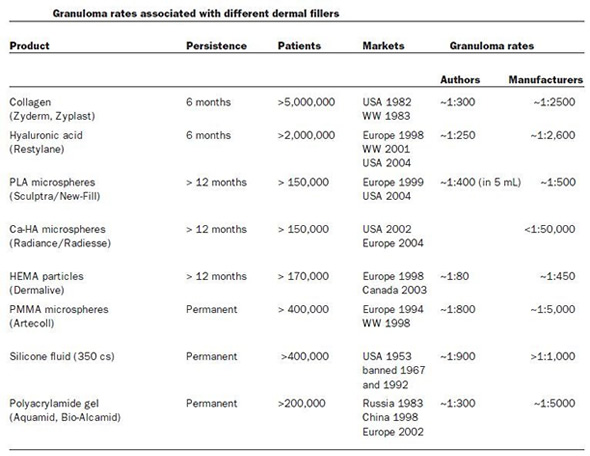
Mole removal is done using either surgical methods for large one or laser for small one (from ¥5,000 + tax for small one and up). Skin tags are treated in similar fashion. Broken veins and Spider veins are removed by laser (from ¥20,000 + tax ~). Other skin lesions such as lesions derived from sun damaged skin can be treat as well.
Whitening (depigmention treatment) Chemical peel is available for better toning of the skin. We have a special peeling for melasma and whitening treatment for hyper-pigmented scars and acne.
Nipple/Areolar area and other pigmented areas can be treated with combined use of whitening medication and special chemical peel. Whitening cream alone often does not improve the condition, so we recommend special chemical peeling in most cases. From 10,000 yen.
Please ask more in detail. You may e-mail your inquiry to info@plazaclinic.net prior to a formal consultation.
Broken veins and Spider veins are removed by laser (from ¥20,000 + tax ~) or by Sclerotherapy injection.
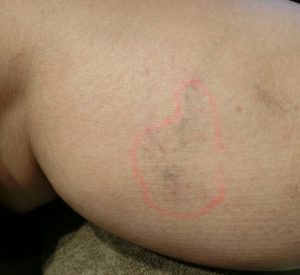
 (spider veins of the thigs)
(spider veins of the thigs)
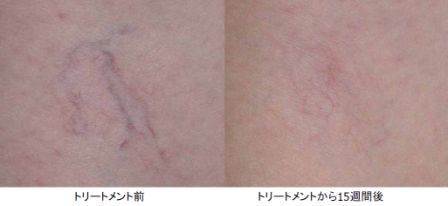
(before/after pictures of spider veins of the thigh with Long Pulse YAG laser)
Other skin lesions such as lesions derived from sun damaged skin can be treated with lasers as well.
Ear piercing, Body piercing available. We use U.S. made piercing that is made of Titanium. It is least allergic to skin. Ear Piercing is from ¥4,500 + tax (one).
Body piercing can be done using local anesthesia without any discomfort to any body areas you wish (for the first one: 15,000 yen + tax including the local anesthesia fee, and from second piercing 10,000 yen/stud +tax). Piercing is done by medical doctors only.
Diet therapy We use prescription medication to control your appetite and increase the metabolism of carbohydrate and fat. Before starting the treatment, you need a brief meeting with our specialist doctor. Please visit our office for more information!
Placenta Extract injection Placenta Extract is medically approved in Japan and manufactured from materials extracted from human placenta. It is tested for viral antigens including HIV and provided from Japanese pharmaceutical companies. It contains numerous fetal growth factors, and it is said to improve skin conditions and to recover from fatigues. From 3,000 yen plus tax.
Second Opinion Consultation
- Unhappy results from treatment/surgery elsewhere?
- Provide pictures from before/after the procedures.
- Bring operative reports if available.
- You may e-mail your inquiry to info@plazaclinic.net prior to a formal consultation.
- Our U.S. Board-Certified plastic surgeon will review and analyze your case, and give you a professional advice.



